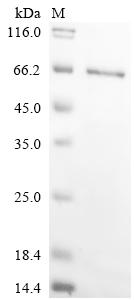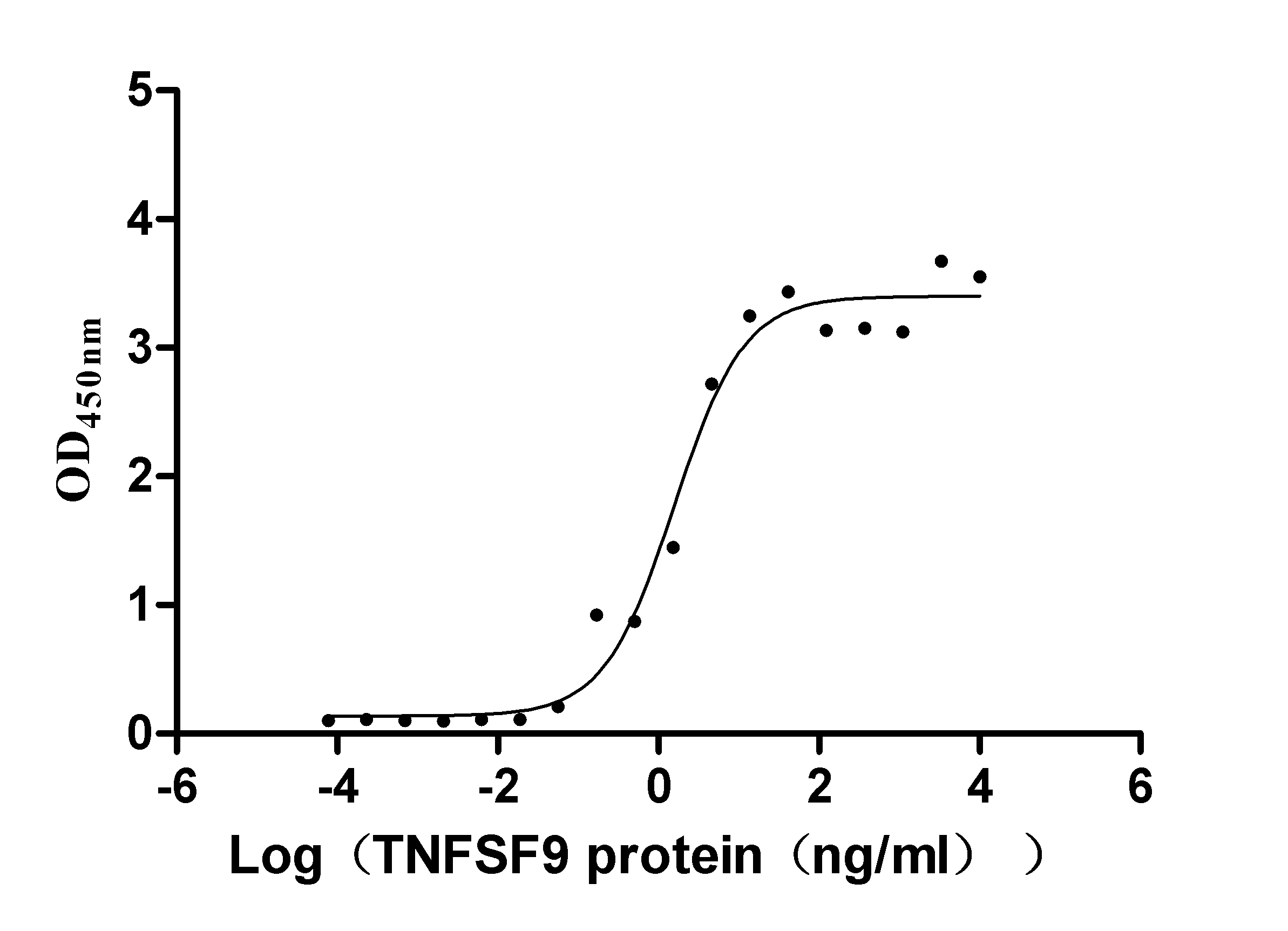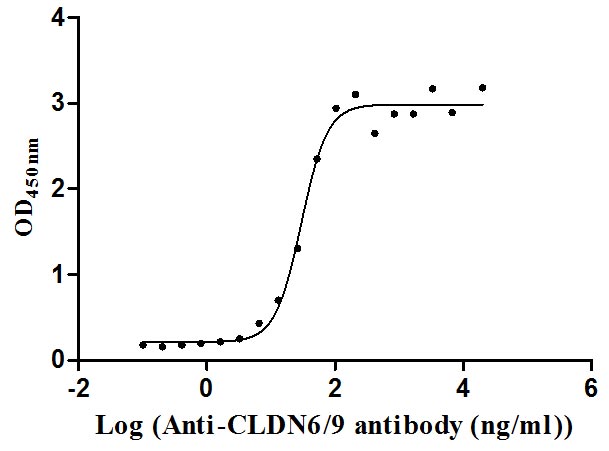Recombinant Rat Chondroitin sulfate proteoglycan 4 (Cspg4), partial
-
中文名稱:Recombinant Rat Chondroitin sulfate proteoglycan 4 (Cspg4), partial
-
貨號:CSB-YP006076RA
-
規(guī)格:¥2208
-
圖片:
-
其他:
產(chǎn)品詳情
-
純度:Greater than 90% as determined by SDS-PAGE.
-
生物活性:Not Test
-
基因名:
-
Uniprot No.:
-
別名:Chondroitin sulfate proteoglycan NG2;HSN tumor-specific antigen
-
種屬:Rattus norvegicus (Rat)
-
蛋白長度:Partial
-
來源:Yeast
-
分子量:53
-
表達區(qū)域:575-1044aa
-
氨基酸序列GPEIFQAYDPDSACEGLTIQLLGVSASVPVEHRDQPGEPVTEFSCRDLEAGNIVYVHRGGPAQDLTFRVSDGMQASGPATLKVVAVRPAIQILHNTGLRLAQGSAAAILPANLSVETNAVGQDVSVLFRVTGTLQFGELQKQGAGGVEGTEWWDTLAFHQRDVEQGRVRYLSTDPQHHTQDTVEDLTLEVQVGQETLSNLSFPVTIQRATVWMLQLEPLHTQNPHQETLTSAHLEASLEEEGEGGPYPHIFHYELVQAPRRGNLLLQGTRLSDGQSFSQSDLQAGRVTYRATTRTSEAAEDSFRFRVTSPPHFSPLYTFPIHIGGDPNAPVLTNVLLMVPEGGEGVLSADHLFVKSLNSASYLYEVMEQPHHGSLAWRDPKGRATPVTSFTNEDLLHGRLVYQHDDSETIEDDIPFVATRQGEGSGDMAWEEVRGVFRVAIQPVNDHAPVQTISRVFHVARGGQRLLTTD
Note: The complete sequence may include tag sequence, target protein sequence, linker sequence and extra sequence that is translated with the protein sequence for the purpose(s) of secretion, stability, solubility, etc.
If the exact amino acid sequence of this recombinant protein is critical to your application, please explicitly request the full and complete sequence of this protein before ordering. -
蛋白標簽:C-terminal 6xHis-tagged
-
產(chǎn)品提供形式:Liquid or Lyophilized powder
Note: We will preferentially ship the format that we have in stock, however, if you have any special requirement for the format, please remark your requirement when placing the order, we will prepare according to your demand. -
緩沖液:If the delivery form is liquid, the default storage buffer is Tris/PBS-based buffer, 5%-50% glycerol. If the delivery form is lyophilized powder, the buffer before lyophilization is Tris/PBS-based buffer, 6% Trehalose.
-
復溶:We recommend that this vial be briefly centrifuged prior to opening to bring the contents to the bottom. Please reconstitute protein in deionized sterile water to a concentration of 0.1-1.0 mg/mL.We recommend to add 5-50% of glycerol (final concentration) and aliquot for long-term storage at -20℃/-80℃. Our default final concentration of glycerol is 50%. Customers could use it as reference.
-
儲存條件:Store at -20°C/-80°C upon receipt, aliquoting is necessary for mutiple use. Avoid repeated freeze-thaw cycles.
-
保質(zhì)期:The shelf life is related to many factors, storage state, buffer ingredients, storage temperature and the stability of the protein itself.
Generally, the shelf life of liquid form is 6 months at -20°C/-80°C. The shelf life of lyophilized form is 12 months at -20°C/-80°C. -
貨期:Delivery time may differ from different purchasing way or location, please kindly consult your local distributors for specific delivery time.
-
注意事項:Repeated freezing and thawing is not recommended. Store working aliquots at 4℃ for up to one week.
-
Datasheet & COA:Please contact us to get it.
相關產(chǎn)品
靶點詳情
-
功能:Proteoglycan playing a role in cell proliferation and migration which stimulates endothelial cells motility during microvascular morphogenesis. May also inhibit neurite outgrowth and growth cone collapse during axon regeneration. Cell surface receptor for collagen alpha 2(VI) which may confer cells ability to migrate on that substrate. Binds through its extracellular N-terminus growth factors, extracellular matrix proteases modulating their activity. May regulate MPP16-dependent degradation and invasion of type I collagen participating in melanoma cells invasion properties. May modulate the plasminogen system by enhancing plasminogen activation and inhibiting angiostatin. Functions also as a signal transducing protein by binding through its cytoplasmic C-terminus scaffolding and signaling proteins. May promote retraction fiber formation and cell polarization through Rho GTPase activation. May stimulate alpha-4, beta-1 integrin-mediated adhesion and spreading by recruiting and activating a signaling cascade through CDC42, ACK1 and BCAR1. May activate FAK and ERK1/ERK2 signaling cascades.
-
基因功能參考文獻:
- chondroitin sulfate proteoglycan 4 (CSPG4) is a potential mesenchymal progenitor cells marker. PMID: 27582000
- These findings indicate that Col VI provided a characteristic microenvironment in the GOR and that NG2-Col VI interactions may regulate the differentiation of osteoblast lineages prior to terminal maturation. PMID: 27498042
- studies suggest that proteoglycan-mediated entrapment upon NG2+ cells is an additional obstacle to CNS axon regeneration. PMID: 25471575
- our data suggested that NG2 proteoglycan expression and secretion hallmarked demarcation as a process that actively separated necrosis from vital tissue and therefore decisively impacts secondary neurodegeneration after ischemic stroke. PMID: 22640018
- In a transient 90-min middle cerebral artery occlusion (MCAO) model of rats, a large ischemic lesion is formed where macrophage-like cells massively accumulate, many of which express a macrophage marker, NG2 PMID: 19861972
- results indicate that NG2 mediates the induction of iNOS and inflammatory cytokine expression, but not the chemokine expression in activated microglia. PMID: 19878709
- NG2+ cells derived from the spinal cord following injury expressed high levels of laminin and fibronectin which promote neurite outgrowth. PMID: 20053907
- identified a novel repeat named CSPG in the central ectodomain PMID: 12220645
- Multiple protein domains of the NG2 proteoglycan inhibit neurite growth and induce growth cone collapse. PMID: 12514214
- The expression patterns and cell associations of inhibitory CSPG4 have important implications for axon regeneration across acute and chronic spinal cord scar tissue. PMID: 12526031
- NG2 is expressed by a distinct cell population in the mature central nervous system with the homogeneous antigenic phenotype of oligodendrocyte progenitors. PMID: 14572468
- After peripheral nerve injury in rats and humans, an accumulation of NG2-positive cells was observed at the injury site. In the rat, there was an increase in NG2 glycanation for at least 2 weeks following injury. PMID: 14664826
- Electroconvulsive seizures dramatically increased the proliferation of amygdala cells expressing the oligodendrocyte progenitor marker NG2. PMID: 15023573
- PKC-alpha-mediated NG2 phosphorylation at Thr(2256) is a key step for initiating cell polarization and motility PMID: 15504744
- Since NG2 loss in a rodent model of hypoxia-ischemia (H-I) occurs around the time of progressive cell death and appearance of the infarct, it may be that H-I rapidly induces a cellular response that actively depletes Ng2 from the hippocampal matrix. PMID: 15817274
- NG2 is expressed by all perivascular cells along arterioles, and its absence denotes a venule-specific phenotype PMID: 15824037
- Ectodomain shedding converts NG2 into a diffusible entity able to interact with the growth cone, and we suggest that this release is likely to enhance its axon growth-inhibitory activity PMID: 15866049
- These data suggest that NG2+ MG in normal developing or pathologic brains are involved in the genesis or regeneration of the brain. PMID: 16534776
- NG2 proteoglycan expression is transiently upregulated along venules during microvascular remodeling PMID: 16627368
- These results suggest that NG2 positive cells which derived from subpial layer, may have some lineage to RG after SCI in adult rodents. PMID: 16902766
- We propose that during development NG2(+)/A2B5(-) cells (pre-OPCs) represent the direct ancestor to A2B5(+) O2A progenitor cells (OPCs). PMID: 17503442
- Differential phosphorylation of NG2 proteoglycan by ERK and Pkca helps balance cell proliferation and cell movement. PMID: 17591920
- NG2 participates in the development and progression of glomerulosclerosis by stimulating proliferation of mesangial cells and deposition of extracellular matrix. PMID: 17686464
顯示更多
收起更多
-
亞細胞定位:Cell membrane; Single-pass type I membrane protein; Extracellular side. Apical cell membrane; Single-pass type I membrane protein; Extracellular side. Cell projection, lamellipodium membrane; Single-pass type I membrane protein; Extracellular side. Cell surface.
-
組織特異性:Neural cells and also extraneural tissues, especially in the developing mesenchyme.
-
數(shù)據(jù)庫鏈接:
Most popular with customers
-
Recombinant Human Tumor necrosis factor receptor superfamily member 9 (TNFRSF9), partial (Active)
Express system: Mammalian cell
Species: Homo sapiens (Human)
-
Recombinant Human G-protein coupled receptor family C group 5 member D (GPRC5D)-VLPs (Active)
Express system: Mammalian cell
Species: Homo sapiens (Human)
-
Recombinant Human Claudin-9 (CLDN9)-VLPs (Active)
Express system: Mammalian cell
Species: Homo sapiens (Human)
-
Recombinant Human Microtubule-associated protein tau (MAPT) (Active)
Express system: Mammalian cell
Species: Homo sapiens (Human)
-
Recombinant Macaca fascicularis Zinc transporter ZIP6 isoform X1(SLC39A6),partial (Active)
Express system: Baculovirus
Species: Macaca fascicularis (Crab-eating macaque) (Cynomolgus monkey)






-AC1.jpg)










